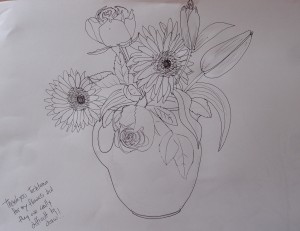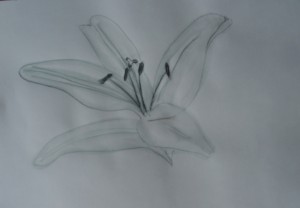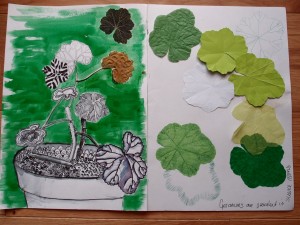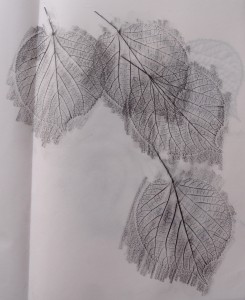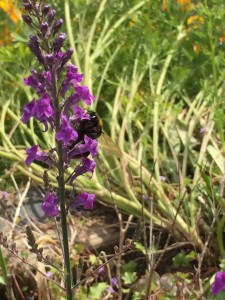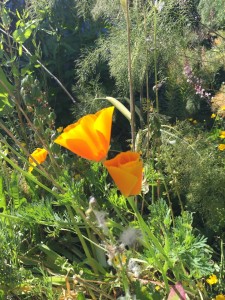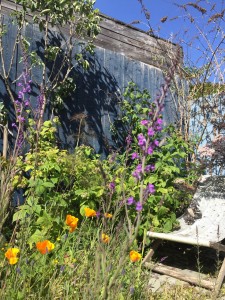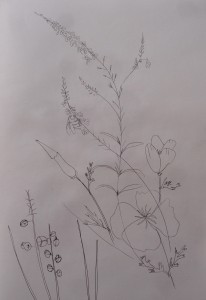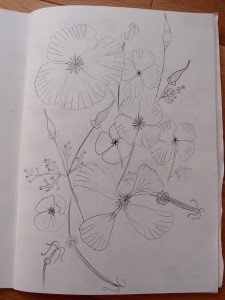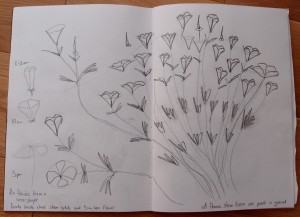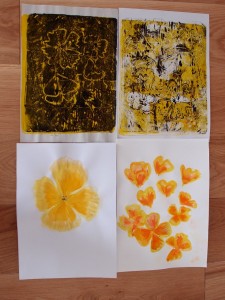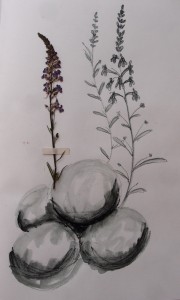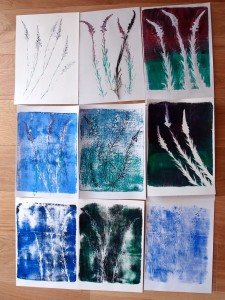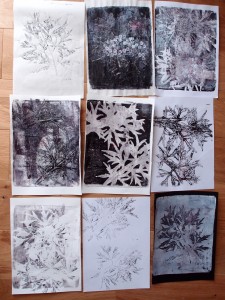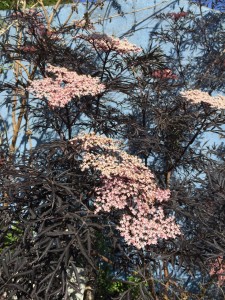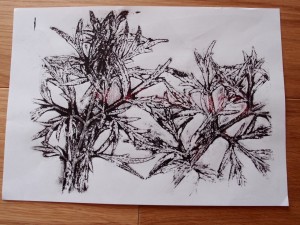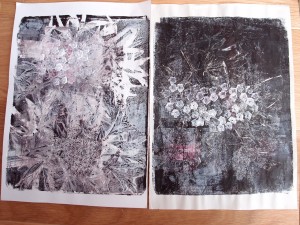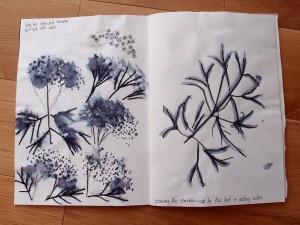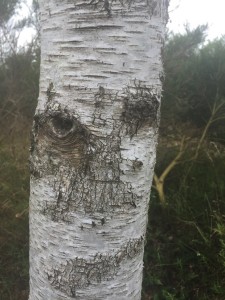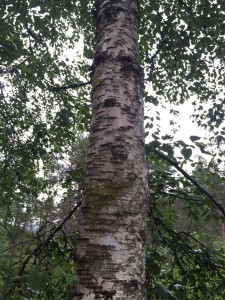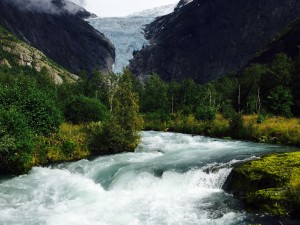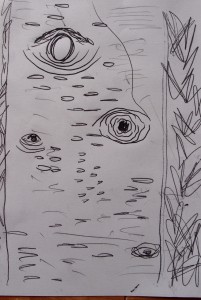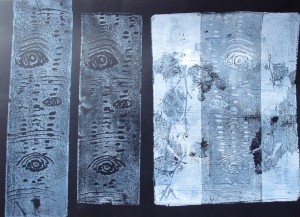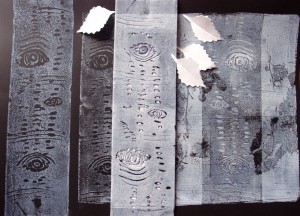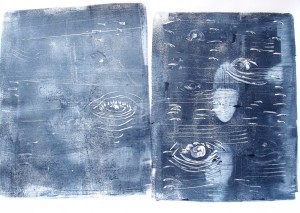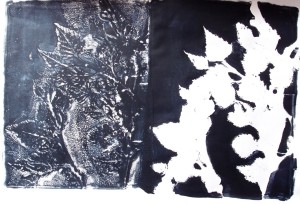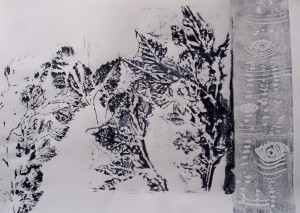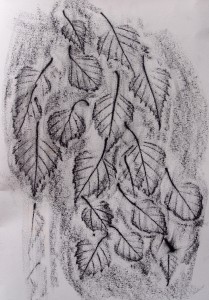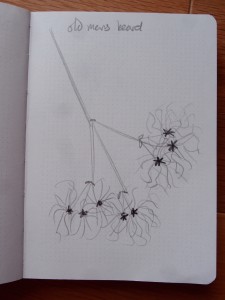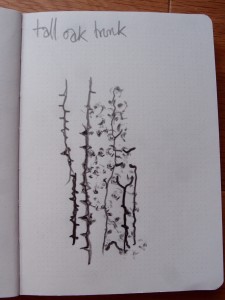Project 3 – Exercise 1.8 Portraying by drawing.
10 drawings of plants- considering, silhouette, tone, repetition, movement, construction, orientation, motifs, flow ,scale, pattern.
….So despite observing my tendency to try to be really representational I really tried to draw this vase of flowers, Its quite a good representation but I do not find it exciting.
Water soluble pencil gives very delicate marks.
This was a quicker drawing where I experimented with different ways to draw geranium leaves and the soil using ink, I prefer the more illustrative style and feel that I came up with some really interesting patterns. I tried cutting leaves from paper and used different techniques such as creasing and embossing on the reverse with a biro to represent the leaf veins. I tried different weights of paper and also used the waste as a stencil to make leaf shaped marks.
I picked some leaves on the way to work to draw in my lunch break. Pen and ink, and frottage work well, very delicate still…
A rather wild affair, my garden.. I love the poppies and made these my first subject.
I started by looking at basic shapes, I can completely understand how drawing from life helps with capturing the essential details of a subject , but drawing plants is really hard!! The sun was either casting shadows of me on the paper or blinding me, and the breeze was not at all helpful, perhaps I will photocopy the line drawings and add colour to them.
I applied yellow paint to the Gelli paint and tried to take a print of the poppies, it was very faint so I rolled black paint over the plate and drew the poppies into the wet surface. This technique doesn’t really suit the delicate nature of the plant at all. I used a watercolour , wasn’t really impressed with the result so cut out the individual flowers and collaged them onto a painted background, this improved the representation some what and enabled me to play a little more with the placement of the flowers.
I like the spherical-ness of the rocks most in this drawing, with this plant. I much prefer the Gelli plate prints, and especially like the direct prints where used two colours.
I used a Gelli plate to make marks directly from the plants in my garden, had lots of fun and got some interesting results.
this is a direct print from the leaves of an ornamental elder type shrub in the garden. I placed it on the Gelli plate and rolled ink over the top, removed the leaves and printed them then took a print of the negative shapes left on the Gelli plate. I really like the marks here, it’s a strong image of a strong plant, I think gardeners would call it architectural. The drawing has a very strong structure, I used black and red acrylic paint, blending them with a roller on the gelli plate and this added a sense of depth, there are some really interesting negative shapes and lovely detail in the veins of the leaves. I think that this is drawing, yet it is an easily achieved representation compared to pen or pencil work, and more interesting than most of my drawings created by more conventional means.
These are two multi layered prints, I rolled white acrylic over the ghost image on the plate and took the print on the left, this added more detail but left a confused image, the image on the right is similarly layered but was a clearer print. The blossom was added from a single floret stamp that I carved from an erasure. I used white acrylic with a smidge of red that was not completely mixed on my pallate, printing three or four times from each inking gave various densities of print , adding depth to the blossom head.
Looking for pattern and repetition.
I really should experiment more with different media, I used an ink pen spritzed with water to disperse the pigment , the drawing on the left was made by casting a shadow on the page and drawing it before adding water, I really like the way water fairly randomly helps make my drawings more interesting, (clearly with an element of expecting that to happen!)
On my holiday to Scandinavia this summer I was beguiled by the beautiful birch…
She became my inspiration and when I got back to rainy England I set out to capture her.
First to solve the tricksyness of drawing in the rain I sealed some carbon paper and paper in a zip lock bag.
I was very pleased when I opened it up when I got back home from my walk. I also took a bit of polystyrene and made marks to print when I got back.
Direct print, acrylic paint on white paper
Direct print and Gelli plate print on black paper.
While the Gelli plate was out I copied some bark marks onto it and really like the subsequent prints. While I was all set up to print I also played with the leaves.
A frottage of falling leaves.
These very quick sketches are possibly my favourites, very textural and quite interesting.
I found that I quested to make ten good drawings and not know where to stop…
Clearly to me my mark making is improving, I become more observant and because of this I want to keep drawing plants until I am really pleased. However I must move on to the next stage. I will keep up my sketching and experimenting.
